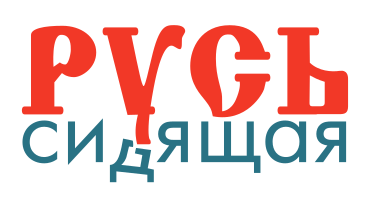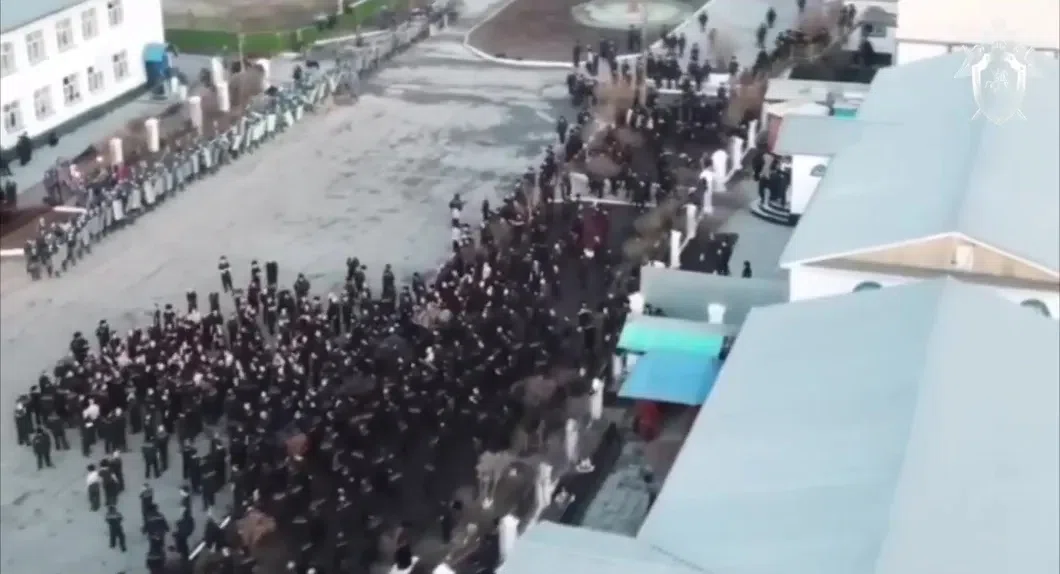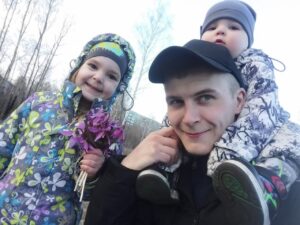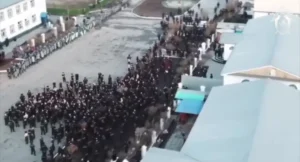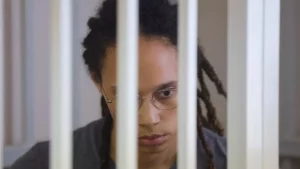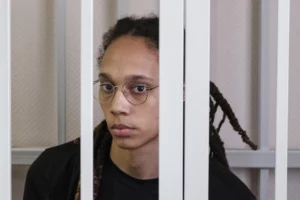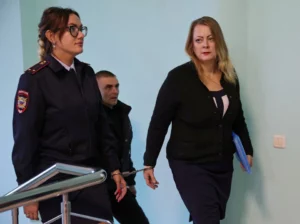Photo by Federal Investigative Committee of Russia
On December 7th, during a regular court session regarding torture in an Angarsk pre-trial detention facility, Denis Poksuaev, who was participating as a victim in this case, recinded his earlier testimony. He allegedly named former co-workers at the facility, Dimitry Baroyan and his boss Vasily Lukovsky, under pressure from investigators.
Now Lukovsky, accused of abuse of power, is under house arrest. And Baroyan – is at “home” in Pre-trial Facility 6, meaning in the same isolation ward where he was previously beating confessions out of riot participants in Angarsk Correctional Colony 15.
Let’s look at a broad overview of this story. On April 9th, 2020 massive riots broke out in Colony-15. According to the official version of events, the cause of the incident stemmed from a conflict with the wardens. One inmate in solitary confinement reports that they allegedly took a packet of cigarettes away during a search. Some inmates, including Pokusaev, say that the riot was staged by the administration itself in order to hide embezzlement in the industrial area of the Colony. Mihail Toroev, a participant of the april events in Colony-15 who was later subjected to torture in detention facility 1, affirms this story in a conversation with Olga Romanova: “It was just a provocation that the cons reacted to. It was all in the hands of the administration. Before the riot, practically everything was hauled out there, all the equipment and so on. They wrote it off as a riot. And everything caught fire simultaneously. All at once. This just can’t be. Even in the farmland, the pigs were all slaughtered, the carcasses were all taken out. It was all taken away before the riot”.
On April 10th a detachment of FSIN (Federal Penitentiary Service) special forces and national guard entered the colony. Also arriving in the Irkutsk region is the new chief of the FSIN head directorate, Leonid Sagalakov. They began by asking the inmates to disperse, and after failing to do so, they sprayed them with hoses from fire trucks. In response, the inmates threw stones. One of which hit Sagalakov in the head – “a vital part of the chief’s body”, as the indictment says (apparently, the torture following the riot was carried out on Sagalokovs direct orders; the tortured individuals were made to shove various items into their orifices, which apparently, are not “vital parts of the body”).
The special forces went on the offensive and cornered the inmates into the industrial area. At some point, fire broke out in multiple places simultaneously and destroyed the entire stockpile of timber along with the machinery (according to the testimony of some inmates, there was no such timber there when the fires broke out). The approximate damages caused by the fire is estimated to be 63 million Rubles ($710.500 at the exchange rate on that date). On April 11th the “rioters” were beaten, undressed, and then taken out of the colony: the largest group going to Pre-trial Facility 1, and the other smaller group – to Facility-6.
It wouldn’t make sense to list every instance of torture here. This was written in detail by Oleg Boldyrev in the article “The biggest torture scandal in Russia is being covered up by multiple court cases” from October 19th of this year. Here we touch only on a few issues arising from the case.
First of all, the specific tactics of Irkutsk investigators attract attention: the riot and torture cases are not being consolidated together in a single proceeding, instead they are examining them separately as if they are independent from one another. Furthermore, the court cases are even conducted separately as if they aren’t one event, but completely different cases. And meanwhile, all these torture cases are linked by the names of “orchestrators”, as well as a number of cells in which the torture was carried out. For Irkutsk investigators this is somehow not a binding component. “Obviously, their objective,” an expert from Russia Behind Bars Peter Kurianov believes, “is to take the case apart piece by piece”.
The fate of the so-called “orchestrators” deserves special attention. They are inmates who directly carried out the torture according to the directions of their curators in uniform. According to one of the cases related to the incidents in Colony-15, the accomplices from Pre-trial Facility 1: inmates Slavgorodsky, Oleynikov, Kurbatov, Gagarin, and Nepomyashi received sentences ranging from 10 to 11 years for the torture of Kejik Ondar. They did their “work” with impunity, and the sentences they were given for the torture cases are a violation of the guarantees of the prison administration. Who knows? Maybe the fate of these sadists from cell 421 will make other “orchestrators” doubt the reliability of their profession.
In some sense, the prison doctors are their accomplices. According to the testimony of the same Pokusaev, medical staff in Angarsk Pre-trial Facility 6 (and clearly in Irkutsk Facility 1 as well) regularly visited the cells where the beaten and raped convicts were kept, but did not document anything. The head of the medical unit even “laughed it off”. This is nothing new however. Even Solzhenitsyn wrote about how, “the prison doctor is the best assistant to the interrogator and executor”. Prison medical units are part of the FSIN system, which means that they cannot go against whatever is handed down to them from above.
Torture in Irkutsk pre-trial facilities are far from an anomaly. But there is one thing that distinguishes Irkutsk’s history: regional investigation and legal proceedings. Recall the Saratov torture case. It went to the central office of the Investigative Committee, while local investigators were in charge of investigating torture in Irkutsk pre-trial facilities. Wasn’t there a reason to send investigators from Moscow to Irkutsk? After all, there is an obvious conflict of interest, (division 1 of the Irkutsk Investigative Committee investigated the mass riots case in Colony-15, while their colleagues from division 3 investigated the cases of torture).
The answers to these questions lie in the realm of symbolism. The Russian state, which has a pathological tendency to leave clues, never answers questions concretely and directly. There are always answers, you just have to learn to read them. Think about it: Arslan Mazhidov, the former head of Angarsk Pre-trial Facility 6, was subsequently promoted to chief of Irkutsk Colony-15. This appointment suggests that the methods used to obtain confessions in facility 6 were approved at the very top. Here’s another curious story: Leonid Sagalakov, the head of FSIN for the Irkutsk Region (the same one who was allegedly hit “in a vital part of his body” with a piece of curb), was promoted to the rank of general by Vladimir Putin after the events in Irkutsk! For the first time in modern Russian history, the man in charge of penitentiary institutions where a record number of crimes were committed (under Article 132 of the Criminal Code), received the general’s epaulettes.
Let’s return to Denis Pokusaev, what prompted him to recant his earlier testimony? Now Pokusaev, who was convicted for fraudulent activities at the construction site, is serving his sentence in the same Pre-Trial facility 6, where in 2020 the “orchestrators” dealt with him. Dmitry Baroyan, the former deputy head of the regime and supervision department of Pre-trial Facility 6 who directly supervised the torture, is also there. Formally, he is accused of committing a crime under Article 286, Part 3 of the Russian Criminal Code (“abuse of power”) and Article 132, Part 2 (“violent acts of a sexual nature by a group of persons by prior conspiracy”). As journalist Eva Merkacheva writes, citing anonymous sources in the Angarsk pre-trial facility: he is in a privileged position in fact, moving freely around the premises of the facility, with access to the other prisoners. If this is true, then Baroyan also has access to Pokusaev, which means that he can theoretically influence his position in the torture case.
Recall the testimony Denis Pokusaev recanted on December 7th. In April 2022, in an interview with Eva Merkacheva he said, among other things, that prisoners brought to facility 6 after the riot in the colony were regularly beaten: “For seven months, almost every day.” They were not allowed to shave for a month, and then they were given one pair of clippers for the whole cell (for six people) beating those who did not finish shaving in a minute and a half. According to Pokusayev, Lukovsky personally participated in the beatings, using a mallet as a weapon: “We were beaten with a mallet. On different parts of the body – head, arms, legs”. During the suppression of the riot Pokusaev’s arm and several ribs were broken, and later in the facility, he was beaten on his broken arm and was not given painkillers. In an interview with Merkacheva, Pokusaev claimed that the torturers acted on behalf of Sagalakov. Allegedly, he personally gave the order to torture the inmates.
As for the other victims, their situation is little better than that of Pokusaev. Inmate Igor Kolosov continues to serve his sentence in the same Irkutsk Pre-trial Facility 1, where he was subjected to sexual torture for a long time. Another victim is now under threat, Sergei Tverdokhlebov, who is also held in Facility 1. On December 12th, Tverdokhlebov went on hunger strike. In a statement addressed to the prosecutor of the Irkutsk region A. V. Khanko, he said that the staff of the facility used psychological and other illegal methods on him in order to force him to give up his testimony against Lukovsky and Baroyan. Fearing for his life and health, Tverdokhlebov asked the prosecutor to take immediate measures of prosecutorial response.
Konstantin GETMANN
